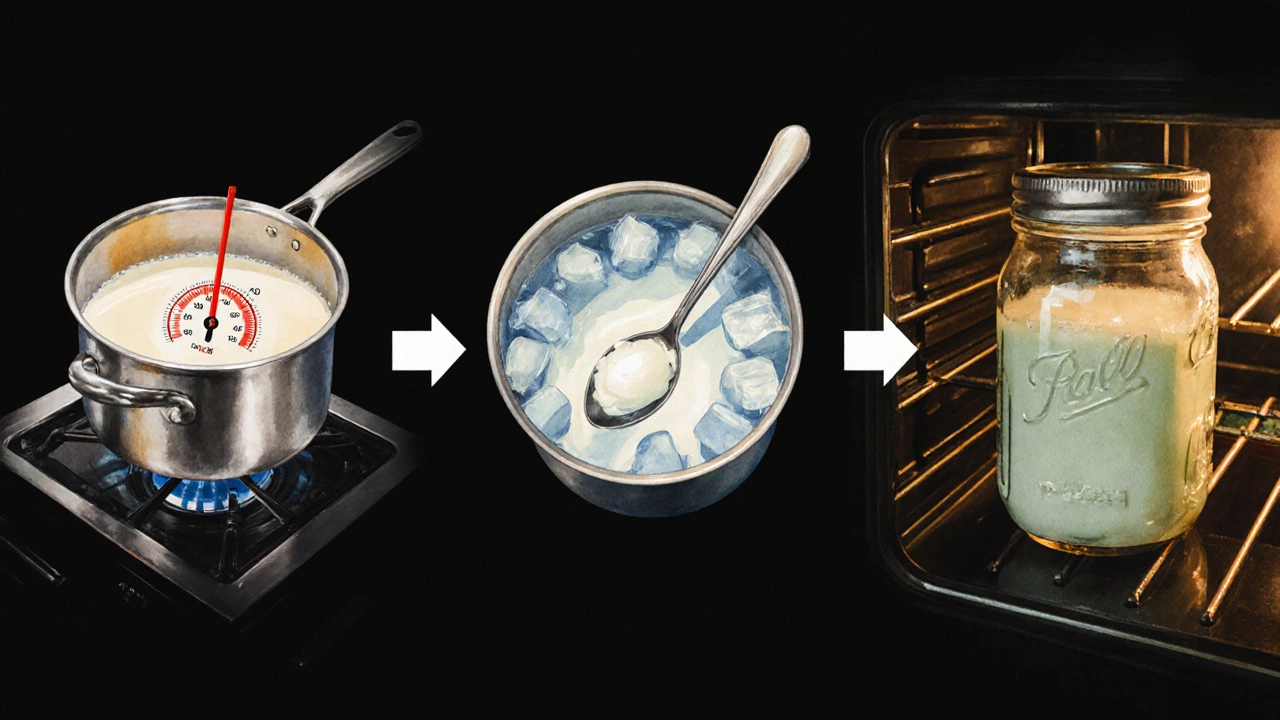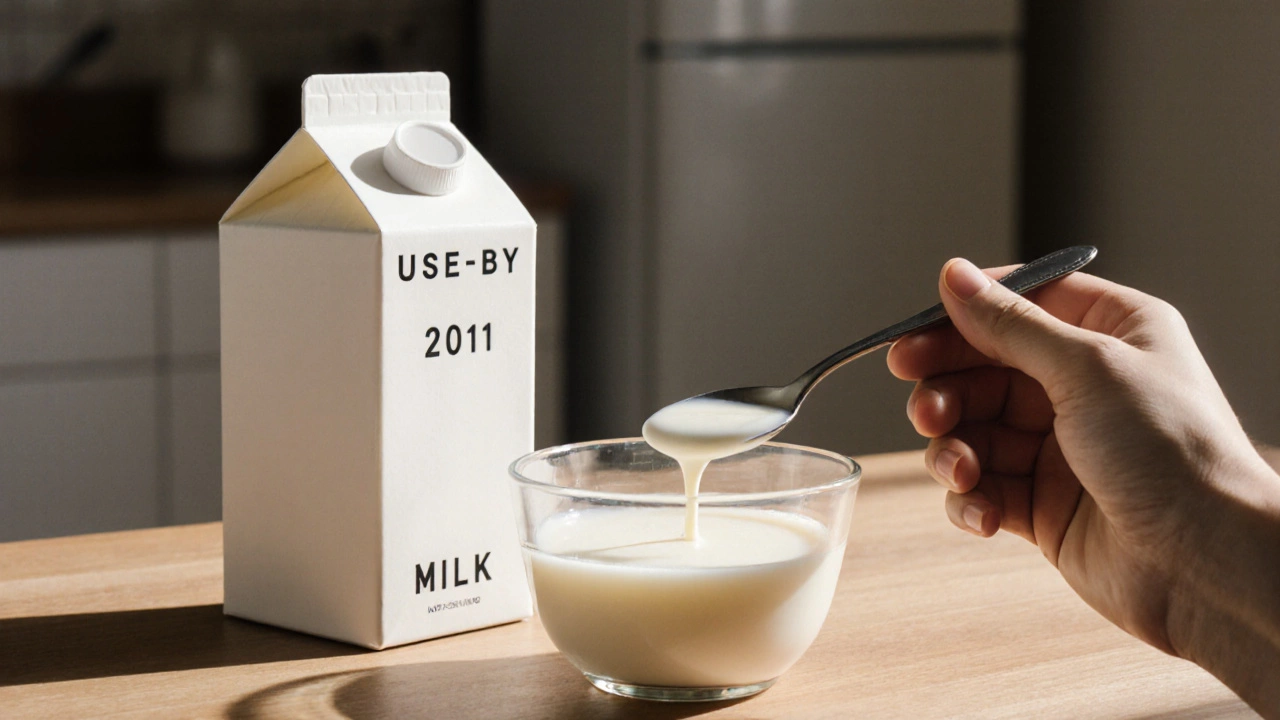17 Oct 2025
- 0 Comments
Yogurt Safety Checker
Yogurt Safety Assessment
This tool helps determine if your milk is safe to use for making yogurt based on the 5-step quality test described in the article.
Results
- Temperature must be ≥45°C (113°F)
- Must pass all visual and smell tests
- Not more than 5 days past expiry if opened
If your milk passes all tests, you can proceed with yogurt making. However, if any condition fails, discard the milk.
Key Takeaways
- Fresh milk gives the most reliable texture, but mildly expired milk can sometimes work if it passes a smell and taste test.
- High‑risk pathogens are rarely present in paste‑urized milk, yet the longer it sits, the higher the chance of spoilage.
- Use a reliable starter culture and keep fermentation temperature between 40‑45°C (104‑113°F) for best results.
- If the milk shows any off‑colours, clots or a strong sour odor, discard it - yogurt won’t fix a bad base.
- When in doubt, treat the milk as expired and buy fresh for a fail‑proof batch.
What "expired" really means on a milk carton
Most dairy cartons list a "use‑by" or "best‑by" date. That date is an estimate of when the product will retain its intended quality, not a hard safety deadline. In Sydney, pasteurised Milk is heated to at least 72°C for 15seconds, which kills the majority of harmful bacteria. After pasteurisation the milk is a relatively clean canvas, but once it cools it can be re‑contaminated from the environment, the container opening, or even the fridge door.
When the date passes, two things happen:
- Flavor and texture begin to change - you may notice a faint sourness.
- Micro‑organisms that survived pasteurisation (mostly harmless lactic acid bacteria) start to multiply.
If the milk is stored at ≤4°C and the carton is unopened, it can stay safe for several days beyond the printed date. Once opened, the clock speeds up and a "good‑until" window of 3‑5 days is typical.
How yogurt is actually made
Yogurt is a fermented dairy product that’s thick, tangy and packed with probiotics. It’s created when lactic acid bacteria convert lactose into lactic acid, giving the characteristic sour taste and causing the milk proteins to coagulate.
The two most common bacterial strains are Lactobacillus bulgaricus and Streptococcus thermophilus. They thrive at a narrow temperature range - about 40‑45°C (104‑113°F). Below that, they work too slowly; above it, they die off.
A starter culture provides a predictable population of these bacteria, ensuring a consistent taste and texture. You can use a store‑bought plain yogurt (with live cultures) or a powdered starter.
During fermentation, the pH drops from around 6.6 to 4.5. This acidification thickens the milk and creates the tangy flavour. If the starting milk is already acidic (as in slightly spoiled milk), the pH may fall too quickly, resulting in a grainy or overly sour product.
When does expired milk become a problem?
Two main safety concerns arise with older milk:
- Pathogenic growth - Though pasteurisation kills most harmful bacteria, some spores (like Clostridium perfringens) can survive and germinate if the milk is left warm for hours.
- Off‑flavours and texture - As lactic acid bacteria multiply, the milk gets naturally sour. Past a certain point the acidity and protein breakdown create clots that are hard to smooth into creamy yogurt.
Visual cues are reliable: any yellowing, pinkish tint, or obvious curdles mean the milk should be tossed. Smell is even more telling - a strong sour or rancid odor indicates that unwanted microbes have taken over.

Simple test to decide if your milk is still usable
- Check the expiry date. If it’s more than 5days past and the carton is opened, plan to discard.
- Give the milk a quick visual inspection. Look for colour changes or large curdles.
- Smell it. A faint tang is okay; a sharp, unpleasant sourness means it’s bad.
- Do the "taste‑check" (optional). Sip a teaspoon. If it’s just mildly tangy, you can proceed. If it’s noticeably sour or has a sour‑off‑flavour, stop.
- Measure the temperature of the milk after heating it to 85°C (185°F) and cooling it to 45°C (113°F). If you can reach the target temp without the milk separating, it’s still structurally sound for yogurt.
If the milk passes all five steps, you can safely move to the fermentation stage.
Step‑by‑step: Making yogurt with (potentially) expired milk
- Heat the milk: Pour the measured amount (usually 1L) into a saucepan. Heat to 85°C (185°F) - this denatures whey proteins and improves texture.
- Cool quickly: Remove from heat and let it sit until it reaches 45°C (113°F). An ice‑water bath speeds this up.
- Add starter: Stir in 2Tbsp of plain yogurt with live cultures or the recommended amount of powdered starter. Make sure the starter is at room temperature.
- Incubate: Pour the mixture into a clean jar or yogurt maker. Keep it at 40‑45°C for 4‑8hours. In a warm kitchen, a turned‑off oven with the light on works well.
- Check firmness: After 4hours, tilt the container. If it’s still runny, give it another hour.
- Refrigerate: Once set, chill for at least 2hours. The yogurt will thicken further.
The only extra step when using older milk is the initial quality check. If the milk passes, the rest of the process is identical.
Fresh milk vs. expired milk for yogurt - quick comparison
| Aspect | Fresh Milk | Expired Milk (still safe) |
|---|---|---|
| Typical pH before fermentation | ≈6.6 | 6.2‑6.4 (slightly more acidic) |
| Texture after incubation | Creamy, smooth | May be grainier if acidity is high |
| Flavor profile | Mild, balanced sourness | Extra tang, sometimes buttery notes |
| Risk of off‑flavours | Low | Higher - watch for strong sour smell |
| Safety window (refrigerated, opened) | Up to 7days | 3‑5days, only if no visual/smell issues |

Pro tips & common pitfalls
- Don’t skip the boil. Heating to 85°C kills any stray microbes that might have entered after opening.
- Use a clean thermometer. Guess‑work leads to under‑ or over‑fermentation.
- If you notice a thin whey layer after incubation, stir gently before chilling - it’s normal.
- Avoid metal containers during incubation; they can affect the bacteria’s activity.
- Label your jars with the start time. Over‑fermenting can push the pH below 4.0, making the yogurt too sharp.
When to say “no” and buy fresh
Even the most careful test can’t guarantee safety if you’re dealing with raw milk or a carton that’s been left out of the fridge for a while. If the milk was stored above 7°C (45°F) for more than a few hours, discard it. Also, if you’re making yogurt for infants, the elderly, or anyone with a compromised immune system, always start with fresh milk.
Frequently Asked Questions
Can I use milk that’s a week past the "use‑by" date?
If the milk has been kept refrigerated, unopened, and shows no off‑colours or smell, it’s often still safe for yogurt. Perform the visual and smell test first.
Will the yogurt taste different with older milk?
Yes, it can be slightly tangier and may have a grainier texture because the milk starts out more acidic.
Do I need to add extra starter when using expired milk?
No extra starter is needed, but make sure the starter you use contains live cultures. The existing lactic bacteria in the milk won’t replace a proper starter.
Is it safe to refrigerate yogurt made from expired milk for a week?
If the yogurt set properly and never showed signs of spoilage during fermentation, it can be stored 5‑7days in the fridge, just like regular yogurt.
Can I use plant‑based milks that are past their date?
Plant milks behave differently; many lack the proteins needed for a firm set. If they’re past the date and already sour, it’s best to discard them.
